*** Disclaimer: We believe all the information in this Vietnam Visa article was correct at the time it was published, however, regulations in Vietnam change often so we urge travelers to not rely solely on the information in this blog post when planning their trip to Vietnam. We cannot be held responsible for any lost monies or travel time due to incorrect information. ***
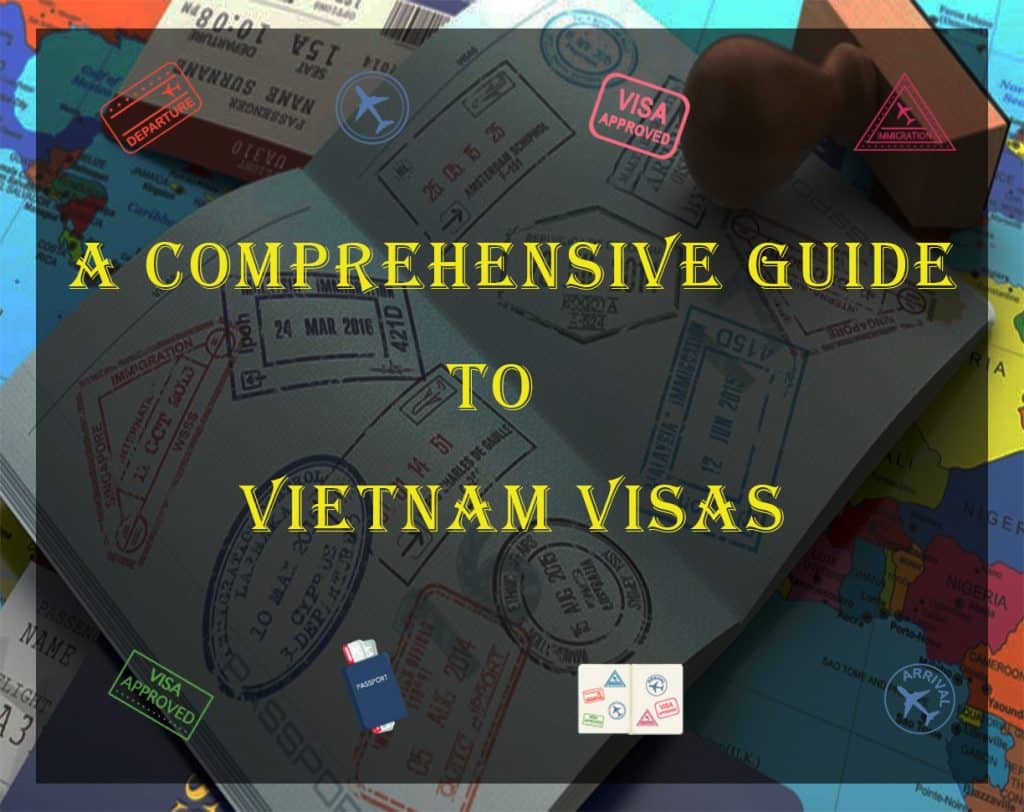
(Please click on the links below to jump directly to the section you would like to read)
TABLE OF CONTENTS
How to Obtain a Vietnam Visa in 2023
So, you’re thinking about Vietnam as your next holiday destination? Great choice! It is a wonderful country, full of equally wonderful people! Whether you’re interested in food, culture, adventure or just relaxing by the beach, Vietnam has something for everyone!
However, before you rush online to book your plane or bus ticket, you should make sure you do your research to ensure you get the most out of your adventure. One of the first things that you will need to find out is if you need to obtain a Vietnam Visa. Most travelers to Vietnam will need to get a visa before being allowed into the country, but there are some exceptions.
Vietnam Visa Exemptions
Citizens of Chile and Panama can stay in Vietnam without a Visa for up to 90 days, which is by far the longest of any country.
If you hold a passport from one of these 7 countries, and your stay is 30 days or less, then you do not require a visa to enter Vietnam:
- Thailand
- Cambodia
- Malaysia
- Singapore
- Indonesia
- Laos
- Kyrgyzstan
*** All foreign travelers flying direct to Phu Quoc Island are also given a 30 day Visa Exemption. If you plan on traveling to the mainland however, and you are not holding a visa exempt passport, then you will need to obtain an E-Visa, VOA or embassy issued Visa ***
If you hold a passport from the Philippines, and your stay is 21 days or less, then you do not require a visa to enter Vietnam.
If you hold a passport from one of these 13 countries, and your stay is 45 days or less, then you do not require a visa to enter Vietnam:
- Japan
- South Korea
- Denmark
- Norway
- Sweden
- Finland
- Russia
- Belarus
- Germany
- France
- United Kingdom
- Spain
- Italy
If you hold a passport from one of these 2 countries, and your stay is 14 days or less, then you do not require a visa to enter Vietnam:
- Brunei
- Myanmar
*** For the latest information regarding Visa Exempt Countries, click HERE ****
To be entitled to visit Vietnam on the visa exemption, there are a couple of things you need to be aware of:
- The day you arrive is counted as your first day. Whether you arrive at 12.10am or 11.45pm, that is still counted as day one. The day you leave is also counted as one of your days. So, in effect, if you have a 15 day Vietnam Visa exemption you are allowed to stay in Vietnam for up to 14 nights. If you have a 30 day Vietnam Visa exemption you allowed to stay for up to 29 nights, etc.
- You will more than likely be required to show proof of onward travel, or proof of exit. Example – an airline, or bus, ticket out of Vietnam dated within the period of your visa exemption.
- Your passport expiration date must be over 6 months from the time of your entry into Vietnam
Also, be aware that there are restrictions on when you can re-enter Vietnam using a visa exemption. If you want to re-enter Vietnam again within 30 days of your last visa-exempt entry, you will need to apply for a new visa in order to be allowed back in. That is, you must stay out of Vietnam for at least 31 days before you can enter using a visa exemption again – update: as of March 15th, 2023, it is NOT required that there is a 31 days before your exit and re-entry for passport holders from the following countries: Germany, France, Italy, Spain, UK, Russia, Japan, South Korea, Denmark, Sweden, Norway, Finland and Belarus
** This rule does not apply to citizens of Cambodia, Thailand, Laos, Malaysia, Singapore, Indonesia, Philippines, Brunei and Myanmar **
There is nothing stopping you from returning to Vietnam within 31 days, but you will need to arrange a Vietnam visa to re-enter. This is quite common as many people enter Vietnam, stay for a few days, and then do a side trip to to another country, before returning to Vietnam.
In a situation like this, one of the entries can be under the visa exemption, and the other using an E-Visa, VOA (Visa on Arrival) or embassy issued visa. It doesn’t really matter which is used for which entry, so long as the exemption is used for a stay of 15 days or less. If you decide to get a VOA (visa on arrival) instead of an E-Visa or embassy issued visa, please be aware that a VOA is only valid for air travel. A VOA cannot be used at a land border crossing.
If you come from a country where the visa exemption doesn’t apply to you, or you’re planning on staying longer than the period you are visa exempt; you have a few visa options: Vietnam E-visa, VOA (Visa on Arrival) and Embassy issued visa. For the purposes of this article, I will list the 3 different types of Vietnam visas in the order of convenience and cost to obtain.
Vietnam E-Visa
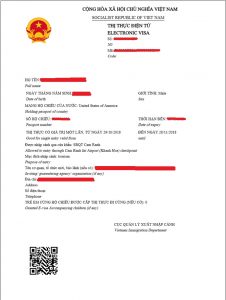
An E-visa is by far the cheapest and easiest way to get a Vietnam Visa. Please don’t confuse a Vietnam E-Visa with the VOA (visa on arrival) because while it’s similar in that you apply for both online, they are very different systems.
So, what is an E-visa?
An E-visa as the name suggest, is a visa issued electronically. You can access Vietnam’s National Web Portal for Immigration and directly apply for a visa using an online form.
First off, there is only one Vietnam e-visa official website: https://evisa.xuatnhapcanh.gov.vn/web/guest/trang-chu-ttdt

If you find any other site purporting to issue e-visas, or any site with the word ‘e-visa’ in their domain name, be aware that they will be acting as a third party. And by acting as a third party, they will charge you a fee for the privilege.
E-visa can be single entry or multiple entry, and is valid for a 90-day period (updated on August 15th, 2023). If you need to stay in Vietnam for more than 90 days you will need to either apply for another e-visa or obtain another visa type through the Vietnam Embassy.
How much does a Vietnam E-Visa cost?
The fee, which is paid at the time of application, is $25 USD.
What do you need to apply for a Vietnam E-Visa?
- Passport with 6 months validity
- One 4×6 passport photo in .jpg format with a white background and no glasses
- One photo of your passport data page in .jpg format
- Your temporary address in Vietnam and ports of entry and exit
- A debit or credit card for payment
It will take around 3-5 days to process your E-Visa
Which countries can use a Vietnam E-VISA?
From August, 2023: Passport holders from all countries and territories are eligible to apply for e-visa on the National Web Portal for Immigration.
Here is a list of the countries that it’s available to:
1. AND – Andorra
2. ARG – Argentina
3. ARM – Armenia
4. AUS – Australia
5. AUT – Austria
6. AZE – Azerbaijan
7. BLR – Belarus
8. BEL – Belgium
9. BIH – Bosnia and Herzegovina
10. BRA – Brazil
11. BRN – Bruney
12. BGR – Bulgaria
13. CAN – Canada
14. CHL – Chile
15. CHN – China including Hong Kong SAR and Macau SAR Passport holder. Does not apply to Chinese e-passport holders
16. COL – Colombia
17. HRV – Croatia
18. CUB – Cuba
19. CYP – Cyprus
20. CZE – Czech Republic
21. DNK – Denmark
22. EST – Estonia
23. FJI – Fiji
24. FIN – Finland
25. FRA – France
26. GEO – Georgia
27. DEU – Germany
28. GRC – Greece
29. HUN – Hungary
30. ISL – Iceland
31. IND – India
32. IRL – Ireland
33. ITA – Italy
34. JPN – Japan
35. KAZ – Kazakhstan
36. KOR – Korea (South)
37. LVA – Latvia
38. LIE – Liechtenstein
39. LTU – Lithuania
40. LUX – Luxembourg
41. MKD – Macedonia The former Yugoslav of
42. MLT – Malta
43. MHL – Marshall Islands
44. MEX – Mexico
45. FSM – Micronesia Federated States of
46. MDA – Moldova
47. MCO – Monaco
48. MNG – Mongolia
49. MNE – Montenegro
50. MMR – Myanmar
51. NRU – Nauru
52. NLD – Netherland
53. NZL – New Zealand
54. NOR – Norway
55. PLW – Palau
56. PAN – Panama
57. PNG – Papua New Guinea
58. PER – Peru
59. PHL – Philippines
60. POL – Poland
61. PRT – Portugal
62. QAT – Qatar
63. ROU – Romania
64. RUS – Russia
65. WSM – Samoa
66. SMR – San Marino
67. SRB – Serbia
68. SVK – Slovakia
69. SVN – Slovenia
70. SLB – Solomon Islands
71. ESP – Spain
72. SWE – Sweden
73. CHE – Switzerland
74. TLS – Timor Leste
75. ARE – United Arab Emirates
76. GBR – United Kingdom of Great Britain and Northern Ireland
77. USA – United States of America
78. URY – Uruguay
79. VUT – Vanuatu
80. VEN – Venezuela
A major advantage of the E-visa is that, unlike a VOA (which you can only use it when entering by air), you can also use an E-visa at land border crossings and certain seaports. A list of the Vietnam border crossing ports:
Cửa khẩu đường không (International airports)
1. SBQT Cát Bi (HPH) – Cát Bi Int Airport (Hải Phòng Province)
2. SBQT Cam Ranh (CXR) – Cam Ranh Int Airport (Khánh Hòa Province)
3. SBQT Cần Thơ (VCA) – Cần Thơ International Airport (Cần Thơ City)
4. SBQT Đà Nẵng (DAD) – Đà Nẵng International Airport (Đà Nẵng City)
5. SBQT Nội Bài (HAN) – Nội Bài Int Airport (Hà Nội City)
6. SBQT Phú Bài (HUI) – Phú Bài Int Airport (Huế City)
7. SBQT Phú Quốc (PQC) – Phú Quốc Int Airport (Kiên Giang Province)
8. SBQT Tân Sơn Nhất (SGN) – Tân Sơn Nhất Int Airport (Hồ Chí Minh City)
9. SBQT Vân Đồn (VDO) – Vân Đồn Int Airport (Quảng Ninh Province)
10. SBQT Thọ Xuân (THD) – Thọ Xuân Int Airport (Thanh Hóa Province)
11. SBQT Đồng Hới (VDH) – Đồng Hới Int Airport (Quảng Bình Province)
12. SBQT Phù Cát (UIH) – Phù Cát Int Airport (Bình Định Province)
13. SBQT Liên Khương (DLI) – Liên Khương Int Airport (Lâm Đồng Province)
Cửa khẩu đường bộ (Landports)
9. Cửa khẩu Bờ Y – Bo Y Landport
10. Cửa khẩu Cha Lo – Cha Lo Landport
11. Cầu Treo – Cau Treo Landport
12. Hữu Nghị – Huu Nghi Landport
13. Hà Tiên – Ha Tien Landport
14. Lao Bảo – Lao Bao Landport
15. Lào Cai – Lao Cai Landport
16. CK La Lay – La Lay Landport
17. Mộc Bài – Moc Bai Landport
18. Móng Cái – Mong Cai Landport
19. Cửa khẩu Nậm Cắn – Nam Can Landport
20. Cửa khẩu Na Mèo – Na Meo Landport
21. Sông Tiền – Song Tien Landport
22. CK Tịnh Biên – Tinh Bien Landport
23. Cửa khẩu Tây Trang – Tay Trang Landport
24. CK Xa Mat – Xa Mat Landport
Cửa khẩu đường biển (Seaports)
25. Cảng Chân Mây – Chan May Seaport (Thua Thien – Hue)
26. Cửa khẩu Cảng Đà Nẵng – Da Nang Seaport (Da Nang)
27. Cảng Dương Đông – Duong Dong Seaport (Phu Quoc, Kien Giang)
28. Cảng Hòn Gai – Hon Gai Seaport (Quang Ninh)
29. Cảng Hải Phòng – Hai Phong Seaport (Hai Phong)
30. Cảng Nha Trang – Nha Trang Seaport (Khanh Hoa)
31. Cảng Quy Nhơn – Quy Nhon Seaport (Binh Dinh)
32. Cảng TP.Hồ Chí Minh – Ho Chi Minh City Seaport (Ho Chi Minh City)
33. Cảng Vũng Tàu – Vung Tau Seaport (Ba Ria – Vung Tau)
34. Cảng Cẩm Phả – Cẩm Phả Seaport (Quang Ninh)
35. Cảng Nghi Sơn – Nghi Sơn Seaport (Thanh Hoa)
36. Cảng Vũng Áng – Vũng Áng Seaport (Ha Tinh)
36. Cảng Dung Quất – Dung Quất Seaport (Quang Ngai)
Vietnam Visa on Arrival (VOA)
As of 2023, individuals can no longer obtain a Visa on Arrival through Visa agents on their own. You can now only obtain Visa on Arrivals through a sponsorship from a tour operator.
Advantages?
Unlike an E-visa you can apply to stay in Vietnam for longer than 30 days. It’s also much cheaper than an embassy issued visa, and you won’t have to trust your postal service with your passport.
The downside?
It’s more expensive than an E-visa and you will have to spend a little extra time at the airport organizing your Vietnam visa when you arrive.
Please note that VOAs are currently only accepted at the following Vietnam airports and are not valid at border crossings and seaports.
- HCMC – Tan Son Nhat International Airport
- Hanoi – Noi Bai International Airport
- Danang – Danang International Airport
- Nha Trang – Cam Ranh International Airport
How much time will it take me to get the VOA once I land?
Well, that depends on how many other people arrive at the same time, who also require a VOA. The wait could be anything from 10 minutes to 2 hours, with it generally being much closer to the shorter time frame, than the longer. You can pay extra for expedited service, but it’s often not required.
So, what do you need to do to arrange a VOA?
First, you need to get an official approval letter from one of the many VOA agents out there. The fee for this service varies from provider to provider but generally ranges between $6-20 USD. Here are 2 reputable companies that can help you obtain a VOA:
- Vietnam Visa Pro – http://vietnamvisapro.net/
- Visa 4 Vietnam – https://www.visa4vietnam.com
Your VOA agent should email you your approval letter a few days after you pay their service fee.
Please keep in mind that the VOA approval letter is not an actual visa, but a letter that is handed in at the VOA counter, to enable you to receive a visa stamp once you arrive at the airport in Vietnam.
Do not be concerned if there are other names on the letter as it’s quite common for agents to make visa applications in bulk. If this does concern you, then most agents can arrange a private letter for you. There is normally an extra fee for this, however.
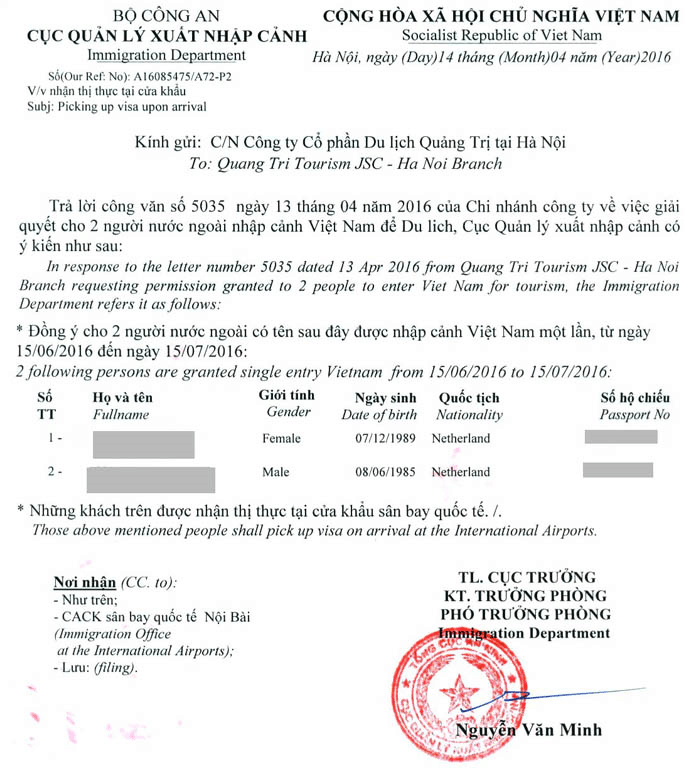
Once you have received the approval letter, print it out in its entirety. The VOA agent will also send you an “Entry and exit” form, and this also needs to be printed out. This form needs to be filled in, and it’s a good idea to do this prior to traveling, so as to save time when you arrive.
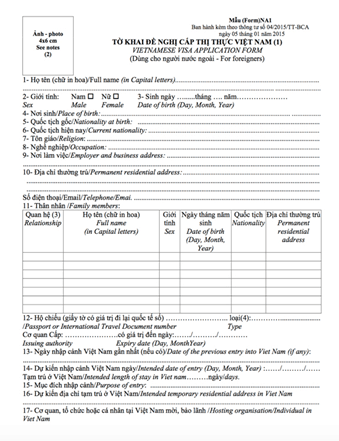
You will also need to supply a passport-sized photo, as well as the visa stamping fee in US dollars.
When you arrive, head straight to the VOA or Landing Visa window. Do not line up at Immigration / Passport control.
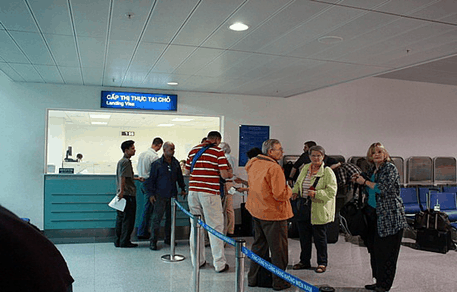
Once you are at the window, hand over your passport, the approval letter, the completed “Entry and exit” form and one passport photo. Then take a seat and wait for your name to be called.
When your name is called, return to the counter and collect your now stamped passport. The stamp looks much the same as the Embassy issued visa (see below).
The visa fee is now paid, which is $25 USD for one and three-month single-entry visas, and $50 USD for one and three-month multiple entry visas. Be sure to check the visa dates in your passport while still at the counter.
When all this is done, you can proceed to the Immigration desk, followed by collecting your luggage on the way out.
Embassy Issued Vietnam Visas
The least convenient and most expensive way to get a Vietnam Visa is to apply for an embassy issued visa. You’ll need to contact the Vietnam Embassy or Consulate in your home country to find out exactly what they require, as well as the cost.
Here is a link to a list of Vietnam Embassies around the world:
http://embassy.goabroad.com/embassies-of/vietnam
Fees obviously vary from country to country, and, if you don’t live near the Embassy, you may have to post your passport in to receive the visa stamp. This will add to the overall cost of your visa, however, and you will risk putting your passport in the hands of your postal service. Some Embassies may offer you the option of a loose-leaf visa, which would negate the need to post your passport.
Once you have your passport back with a Vietnam visa, you are good to go. There will be nothing more to pay on arrival in Vietnam, and when you do arrive, proceed directly to Immigration / Passport control.
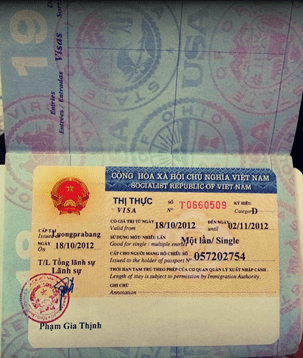
We hope you found this Comprehensive Vietnam Visa guide useful! If Ho Chi Minh City is one of your stops in Vietnam, you might consider checking out one of our 3 acclaimed city tours. XO Tours has been one of the top-ranked tour operators in Vietnam for over 9 years running, as voted by the users of Tripadvisor. Our “XO Foodie” tour is the original Vietnam street food tour and was recently named one of the top 9 food tours in the world by Forbes magazine.








